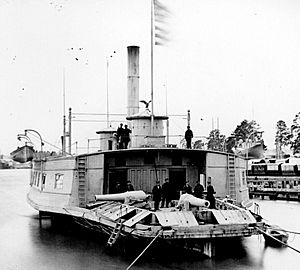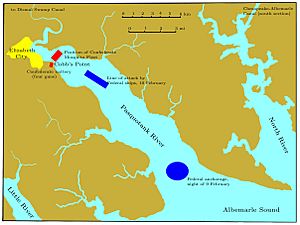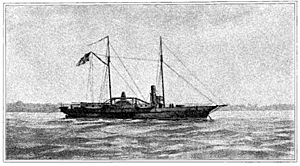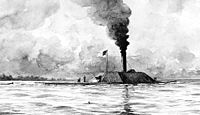Battle of Elizabeth City facts for kids
Quick facts for kids Battle of Elizabeth City |
|||||||
|---|---|---|---|---|---|---|---|
| Part of the American Civil War | |||||||
 USS Commodore Perry's guns, 1864 |
|||||||
|
|||||||
| Belligerents | |||||||
| Commanders and leaders | |||||||
| Strength | |||||||
| 13 gunboats | Land: ~34 men 4 artillery pieces Sea: 5 gunboats 1 schooner |
||||||
| Casualties and losses | |||||||
| 2 steamers damaged 2 killed 7 wounded |
1 steamer sunk 1 armed tug captured 1 steamer scuttled 1 armed tug scuttled 1 schooner scuttled 5 killed 7 wounded 34 captured |
||||||
The Battle of Elizabeth City was a naval fight during the American Civil War. It happened on February 10, 1862, on the Pasquotank River near Elizabeth City, North Carolina. This battle took place right after the Battle of Roanoke Island.
The fight was between ships of the U.S. Navy and the Confederate Navy. The Confederate ships were part of their "Mosquito Fleet." They also had help from a land battery with four cannons at Cobb's Point. This battle was part of a bigger plan called the Burnside Expedition. It was led by Major General Ambrose E. Burnside. The Union won the battle. They took control of Elizabeth City and its waters. Most of the Confederate fleet was captured, sunk, or scattered.
Contents
Why Was Elizabeth City Important?
At the start of the Civil War, the Union wanted to cut off the Confederacy. Their plan, called the Anaconda Plan, aimed to stop supplies from reaching the South. A key part was to blockade the Confederate coast. This meant preventing ships from Europe from reaching Southern ports.
Elizabeth City was important because of its location. It sits near where the Pasquotank River flows into Albemarle Sound. Two important canals, the Dismal Swamp Canal and the Albemarle and Chesapeake Canal, were nearby. These canals were used to transport food and supplies from North Carolina to Norfolk, Virginia. Norfolk relied on these canals for its food.
If the Union could control these waterways, they could cut off supplies to Norfolk. This would weaken the Confederacy.
How Did Roanoke Island Change Things?
In early February 1862, the situation changed. On February 7-8, Union forces captured Roanoke Island. This island had protected the sounds from Union ships. Before, Union ships had to pass Confederate forts on Roanoke Island. With the island captured, the only thing left was the Confederate "Mosquito Fleet."
Preparing for Battle
The Confederate Mosquito Fleet's Defense
The Battle of Roanoke Island started on February 7, 1862. Union gunboats attacked four Confederate forts and eight Confederate ships. The Confederate ships were part of the "Mosquito Fleet." This fleet was led by Flag Officer William F. Lynch.
During the battle, one Confederate ship, CSS Curlew, was badly damaged. It was burned to keep it from the Union. Another ship, CSS Forrest, was damaged when it hit something underwater. It could not move on its own. The rest of the Mosquito Fleet had little damage. But they ran out of ammunition.
Flag Officer Lynch took his fleet to Elizabeth City. He hoped to get more supplies and fix Forrest. He could not find much ammunition. He sent two ships, CSS Appomattox and CSS Raleigh, to get more. Raleigh did not return in time for the battle.
So, Lynch had six ships ready for battle. Each ship had enough ammunition for only ten shots. His main ship was Sea Bird. He also had three former tugboats: Appomattox, Ellis, and Beaufort. Another ship, Fanny, was a captured transport vessel. The last ship was Black Warrior, a schooner. Besides his ships, Lynch also relied on the four cannons at Cobb's Point.
The Union Fleet's Attack Plan
After the Union captured Roanoke Island, their ships could enter Albemarle Sound. Flag Officer Louis M. Goldsborough ordered his gunboats to chase and destroy the Mosquito Fleet. Some Union ships were damaged, so 14 ships were chosen for the chase. These 14 ships had a total of 37 cannons. Commander Stephen C. Rowan led this Union fleet.
All 14 Union ships were civilian vessels changed into warships. Rowan's main ship was Delaware. Other ships included Hetzel, Ceres, and Commodore Perry.
The Union fleet also had low ammunition. So, Commander Rowan told his captains to save their shots. He ordered them to try ramming or boarding enemy ships. This meant crashing into them or having soldiers jump onto the enemy ship to fight hand-to-hand.
On February 9, Rowan's gunboats crossed Albemarle Sound. They reached Elizabeth City as night fell and anchored there.
The Battle Begins
Flag Officer Lynch prepared his ships for the Union attack. He placed the schooner CSS Black Warrior near the Cobb's Point battery. His five steamships were lined up across the river, a bit upstream. He thought the Union would attack the battery first. Lynch told his captains not to let their ships be captured. If they had to, they should escape or destroy their ships.
On the morning of February 10, Lynch visited the Cobb's Point battery. He found only seven militiamen and one civilian there. Since the battery was key to his defense, he ordered Lieutenant Commander William Harwar Parker and most of his crew from CSS Beaufort to man the cannons. This left only enough men on Beaufort to move it up the canal. Even with more men, only three of the four cannons could be used. When the battle started, the militiamen ran away. Only two cannons were left to fight the Union.
The battery did not matter much in the end. Commander Rowan knew his ammunition was low. His main goal was to destroy the Confederate fleet. So, he ordered his ships to go past the battery. Parker and his men fired a few shots, but they missed. Their cannons could not reach the Union ships once they moved upstream. They could only watch as their ships were destroyed.
The first Confederate ship lost was the schooner Black Warrior. The Union fleet fired on it as they passed. Its crew left the ship and set it on fire. Likewise, Fanny was run ashore and burned. A group of Union sailors from Ceres captured CSS Ellis in a hand-to-hand fight. Her captain tried to blow up Ellis, but a crew member stopped him.
CSS Sea Bird tried to escape. But Commodore Perry chased it down and sank it. CSS Beaufort and Appomattox managed to escape into the Dismal Swamp Canal. However, Appomattox was too wide for a canal lock, so it was burned. CSS Forrest, which was being repaired, was also burned. An unfinished gunboat was burned too. CSS Raleigh was still in Norfolk and was not harmed. Only Beaufort and Raleigh escaped capture or destruction.
Few people were hurt in the battle. The Union fleet had two men killed and seven wounded. The Confederates had four killed, six wounded, and 34 captured. Quarter Gunner John Davis received the Congressional Medal of Honor for his bravery on Valley City.
What Happened Next?
When Confederate troops learned their fleet was destroyed, they set fires in Elizabeth City. They were following orders from Brigadier General Henry A. Wise. About two blocks of the town were burned. But Union sailors arrived and saved the rest of the city.
The Confederates also tried to block the Albemarle and Chesapeake Canal. Union forces finished blocking it later.
The town of Edenton was taken by Union gunboats on February 12. No fighting happened there. Two schooners were captured, and another was destroyed. Eight cannons were also taken. After this, the Confederates had no presence on Albemarle Sound for most of the war. The only challenge came in 1864 from a Confederate ship called CSS Albemarle.
Norfolk, Virginia, was not attacked directly. But it became cut off and less useful to the Confederate Army. In May, the city was abandoned.
Ships in the Battle
Confederate Ships:
- CSS Sea Bird (flagship, sidewheel steamer)
- CSS Fanny (tugboat)
- CSS Appomattox (tugboat)
- CSS Ellis (tugboat)
- CSS Beaufort (tugboat)
- CSS Black Warrior (schooner)
Union Ships:
- USS Delaware (flagship, sidewheel steamer)
- USS Hetzel (sidewheel steamer)
- USS Isaac N. Seymour (sidewheel steamer)
- USS John L. Lockwood (sidewheel steamer)
- USS Ceres (sidewheel steamer)
- USS Shawsheen (sidewheel steamer)
- USS Commodore Perry (sidewheel steamer)
- USS Morse (sidewheel steamer)
- USS Louisiana (screw steamer)
- USS Underwriter (screw steamer)
- USS Valley City (screw steamer)
- USS Whitehead (screw steamer)
- USS Henry Brinker (screw steamer)





